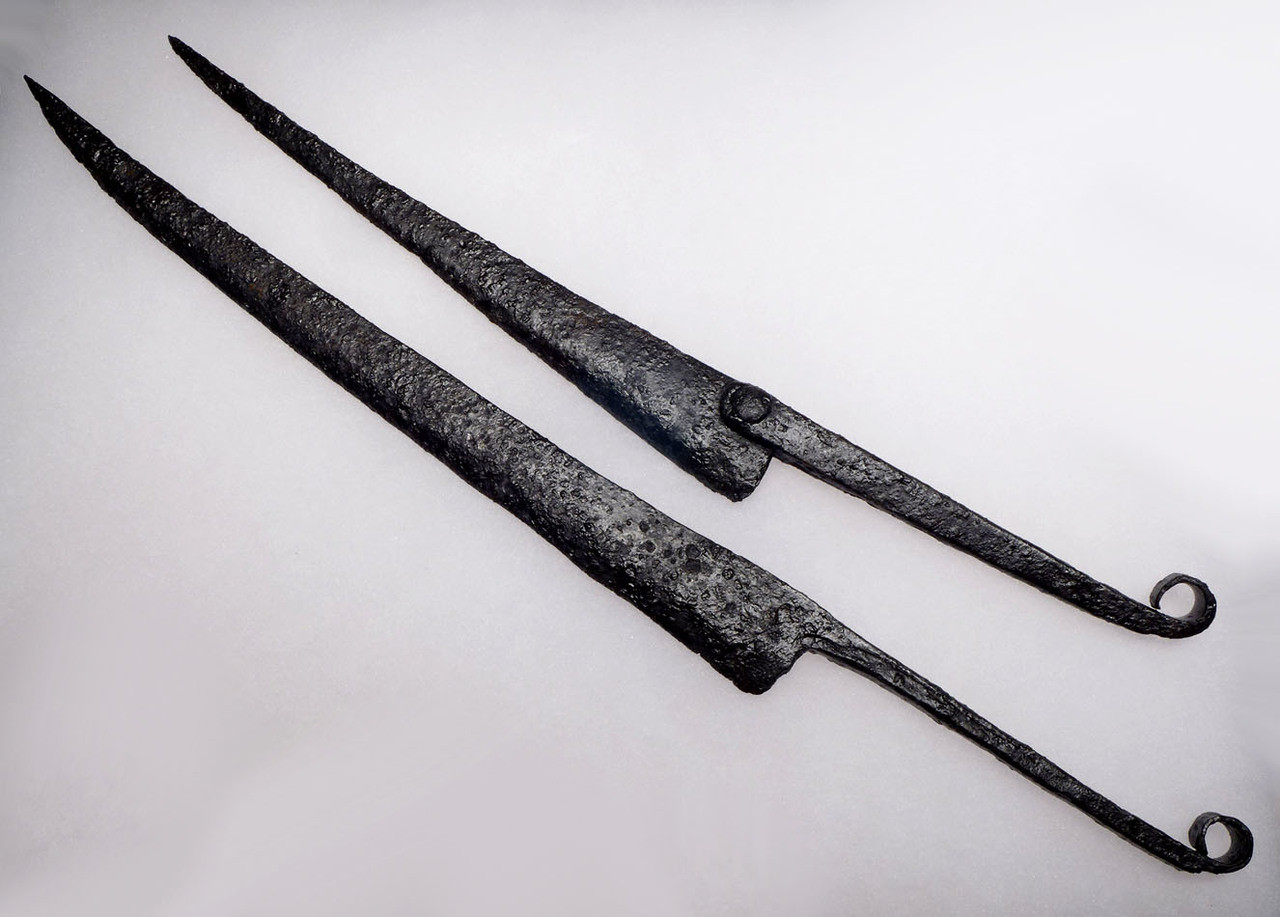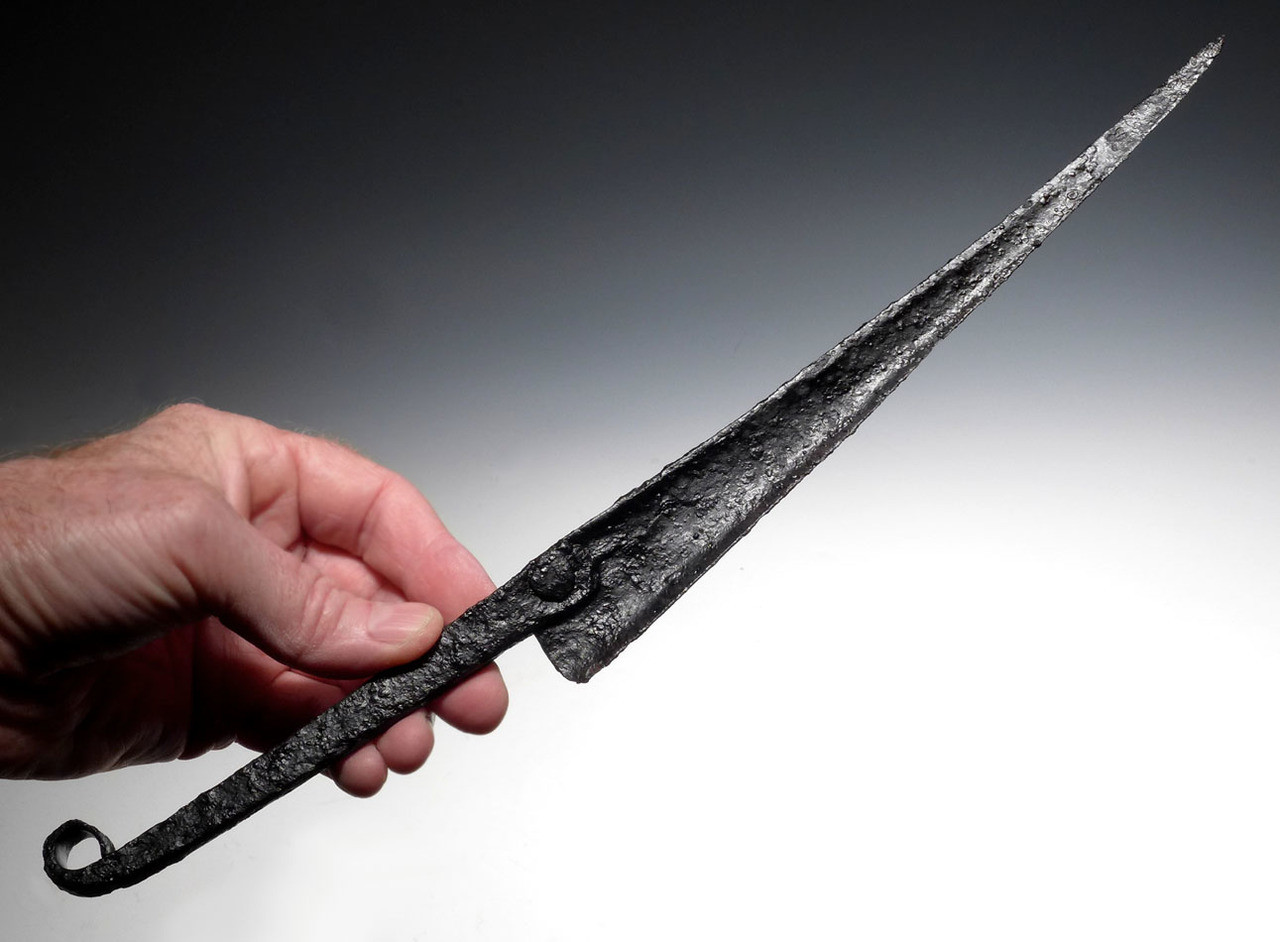Product Description
These two ancient iron large stabbing knife swords are attributed to the early Ancient Persian Empire. Both show rare, complete preservation and are intact from their sharply pointed tips down to the ring pommel on the integral handle. The elongated blades are curved to impart strength in stabbing attacks to prevent the blade from bending. From a private German collection focused on ancient weapons of the Balkans, these two unique examples were amongst the best of the large bladed weapons in the collection. Their style is unique and later steel knife swords of the Persians would imitate the profile of these earliest of knife swords in ancient iron! Both artifacts have been professionally cleaned and conserved in our lab, being treated with a special sealer for ancient metal preservation.
WARNING: There is an increasing number of fake ancient weapons on the market. As fine quality original specimens become more scarce, techniques have become more sophisticated to fake these weapons. The degree to which the fakers have been able to replicate patina to disguise their work requires an expert examination by highly experienced individuals. It is common to find very reasonably priced weapons that are made up of part original and part modern components or wholly modern pieces displaying elaborate artificial patinas. All purchases should include from the dealer a written guarantee of authenticity with unconditional and lifetime return policies regarding such guarantee.
HISTORY
The Achaemenid Empire (c. 550–330 BC), also called the First Persian Empire, was an empire based in Western Asia, founded by Cyrus the Great. At its greatest extent, it ranged from the Balkans and Eastern Europe in the west, to the Indus Valley in the east. It was larger than any previous empire in history, spanning 5.5 million square kilometers. Incorporating various peoples of different origins and faiths, it is notable for its successful model of a centralized, bureaucratic administration (through satraps under the King of Kings), for building infrastructure such as road systems and a postal system, the use of an official language across its territories, and the development of civil services and a large professional army. The empire's successes inspired similar systems in later empires.
By the 7th century BC, the Persians had settled in the southwestern portion of the Iranian Plateau in the region of Persis, which came to be their heartland. From this region, Cyrus the Great advanced to defeat the Medes, Lydia, and the Neo-Babylonian Empire, establishing the Achaemenid Empire.
Alexander the Great, an avid admirer of Cyrus the Great, conquered most of the empire by 330 BC. Upon Alexander's death, most of the empire's former territory came under the rule of the Ptolemaic Kingdom and Seleucid Empire, in addition to other minor territories which gained independence at that time. The Iranian elites of the central plateau reclaimed power by the second century BC under the Parthian Empire.
The Achaemenid Empire is noted in Western history as the antagonist of the Greek city-states during the Greco-Persian Wars. The empire was instrumental in the spread of Zoroastrianism as far east as China. The empire also set the tone for the politics, heritage and history of modern Iran.
The Persian cavalry was crucial for conquering nations, and maintained its importance in the Achaemenid army to the last days of the Achaemenid Empire. The cavalry were separated into four groups. The chariot archers, horse cavalry, the camel cavalry, and the war elephants.
In the later years of the Achaemenid Empire, the chariot archer had become merely a ceremonial part of the Persian army, yet in the early years of the Empire, their use was widespread. The chariot archers were armed with spears, bows, arrows, swords, and scale armour. The horses were also suited with scale armour similar to scale armour of the Sassanian cataphracts. The chariots would contain imperial symbols and decorations. The horses used by the Achaemenids for cavalry were often suited with scale armour, like most cavalry units. The riders often had the same armour as infantry units, wicker shields, short spears, swords or large daggers, bow and arrow and scale armour coats. The camel cavalry was different, because the camels and sometimes the riders, were provided little protection against enemies, yet when they were offered protection, they would have spears, swords, bow, arrow, and scale armour. The camel cavalry was first introduced into the Persian army by Cyrus the Great, at the Battle of Thymbra. The elephant was most likely introduced into the Persian army by Darius I after his conquest of the Indus Valley. They may have been used in Greek campaigns by Darius and Xerxes I, but Greek accounts only mention 15 of them being used at the Battle of Gaugamela.
 US DOLLAR
US DOLLAR
 EURO
EURO
 AUSTRALIAN DOLLAR
AUSTRALIAN DOLLAR
 CANADIAN DOLLAR
CANADIAN DOLLAR
 POUND STERLING
POUND STERLING


















